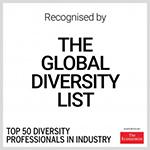
World Social Justice Day – Advantaged versus Disadvantaged
Organisations being reflective of the society we live in, we should familiarise ourselves with the frameworks of social justice. It will help us understand the process of how being disadvantaged impacts individuals representative of certain groups adversely.
On reflection, you will realise that multiple descriptors can be used to describe your identity. Gender, class, ethnicity, religion, physical ability and appearance are a few of these descriptors. Identity being intersectional of these descriptors, one may be advantaged, say as a heterosexual male while being disadvantaged, say as a physically challenged person at the same time.
An indicative activity by Dr Warren J. Blumenfeld showed that when people were asked to fill in the blanks of ‘I am ___________,’ they used descriptors which made them feel disadvantaged. The activity helped Dr Blumenfeld realise the importance people tend to give to negative perceptions, and at the same time underappreciating their privileges. With this in mind, let’s deep dive into how being disadvantaged is a reality, one which can happen to any of us. Here are a few terms throwing light on how the disadvantaged can be exploited in organisations:
Hegemony:
When a person has internalised that being controlled by another is just simply business as usual, they are at risk of being subjugated to harassment. For example, in a hostile work environment, one may be at risk of sexual harassment. Another prevalent form of hegemony is taking accessibility for granted and its barriers for persons with disability just like being privileged enough to be akin to a fish in the water. People are negatively impacted through their reality not being normalised and with them being forced to work in an environment which is not equitable.
Silos:
In every office environment, there may be informal groups. While on the surface, it may seem like everything is fine, silos may negatively impact abilities to collaborate at work especially among the minority group. It would be difficult for people to get their work done especially when they have to interact with those outside their social group.
Tokenism:
Certain leaders who want to appear just and fair may try the quick fix method of choosing a person from the minority group for social acceptance or professional advancement. It is a subtle way of controlling the person from the minoritized group while the leader retains their sense of power and control. Often leaders may cite anecdotal evidence depicting progress when you bring up statistics proving discrimination against the disadvantaged. While anecdotal evidence shows that there are some who care for the minoritised, these are exceptions which undermine statistics in support of minorities.
Also Read: Four Signs That Your Diversity Hiring Isn’t Working
Stereotypes:
Being a part of groups is unavoidable at work but one may be prejudged about their personality, work etc., without being aware of it. Representatives of a particular group may be typecast into boxes which restrict abilities to work effectively beyond their control. Stereotypes are another way to justify the subjugation of another person. It can have far-reaching consequences like workplace anxiety and undue pressure affecting work productivity if forced to fit into a norm.
Scapegoat:
Disadvantaged people can appear as soft targets to the dominant group and maybe blamed or accused of no offence of their own. A tendency exists for certain groups or individuals to consider others as inferior and this can lead to further ostracization. Being singled out is an unpleasant experience and one must be empowered enough to stand up for themselves and others. The loss of social status, economic power, social isolation, and depression can have a negative impact on people.
The terms we discussed above describes ways in which the power equation is established at work by the dominant groups. People should make an active effort of recognizing and curbing these behaviours that diminish the culture of employee wellbeing across organisations.
Let’s be active bystanders instead of a passive one when we observe controlling behaviours. Being there for each other will help us grow and strengthen the bonds made in our inclusion journey professionally.
Interweave Consulting is one of India’s first consulting firm exclusively focused on Diversity and Inclusion. Our interventions are designed to help organisations in their inclusion journeys.
To know more about our offerings, write to us at interweavesolutions@interweave.in
or
call us at 80 4148 2787
By Sandra Sebastian
—————————————————————————————————————————————-
Bibliography:
- SENSOY, O. (2017). IS EVERYONE REALLY EQUAL? : TEACHERS COLLEGE Press.
- Adams, M., Blumenfeld, W., Catalano, D., DeJong, K., Hackman, H., Hopkins, L., Love, B., Peters, M., Shlasko, D. and Zúñiga, X. (n.d.). Readings for diversity and social justice.











